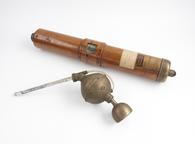

X-ray focus tube with adjustable anti-cathode.
- Made:
- 1901-1909
X-ray focus tube with adjustable anti-cathode, Watson & Sons (Electro-Medical) Limited, 1901-1909
Russell John Reynolds (1880-1964) was an internationally renowned radiographer and specialist in the field of cineradiography or moving image X-ray films. While still at school, he – with the assistance of his GP father John Reynolds – constructed a fully functioning X-ray machine just months after German scientist Wilhelm Röntgen first described the ‘new type of ray’ in 1895.
Physicists, including William Crookes – a friend of Reynolds’ father – had been experimenting for some time with discharge tubes; glass bulbs with a partial vacuum and electrodes at either end. These could be made to glow yellow-green when high voltages were applied. Röntgen discovered X-rays using this type of tube, and Reynolds’ machine also relied on Crookes’ invention.
Five years later, Reynolds – by then a medical student at Guy’s Hospital – obtained a patent for an improved means of adjusting the electrodes enclosed in vacuum tubes. Optical instrument maker W. Watson and Sons agreed to manufacture Reynolds’ new design.
Details
- Category:
- X-rays
- Object Number:
- 1909-186/33
- type:
- x-ray tube
- credit:
- British Institute of Radiology; Röntgen Society




